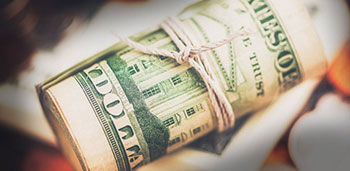A JUDGEMENT CALL
Tough decisions are made tougher with a short bankroll
By John Grochowski
 It’s easy to tell others there’s a right way and a wrong way to play video poker hands when it’s their money at risk and not yours.
It’s easy to tell others there’s a right way and a wrong way to play video poker hands when it’s their money at risk and not yours.
I’m happy enough to tell 9-6 Double Double Bonus Poker players the average return is higher when they hold three aces than when they hold a full house with aces up. Similarly, when Super Double Bonus Poker pays 8-for-1 or less on full houses, breaking up a full house to hold three kings, queens or jacks has a higher expected value than standing pat.
Still, when you see king-king-king-7-7 on your screen in Super Double Bonus, you have to make a judgment call: keep the full house and take a 40-coin payoff for a five- coin bet, or toss the low pair and take the 1 in 47 shot at a 600-coin bonanza for the fourth king.
If you’re short on credits, you’ll be sorely tempted to keep the full house even though the average return for holding the three kings alone is 41.44 coins per five wagered – nearly a coin and a half better than holding the pat hand.
If you’re fortunate enough to find a Super Double Bonus machine that pays 9-for-1 on a full house, there’s no dilemma. The flat 45-coin pays for standing pat is the way to go.
But when you’re weighing a flat 40-coin return vs. a potential 41.4 return, but a likelihood of dropping to 15, I can’t blame a player with a limited bankroll for thinking twice.
A reader recently took the dilemma to another level, writing that he plays 8-5 Super Double Bonus on a quarter Ten Play Poker machine.
“I can see where the strategy by math would be to break up the full house and go for the 600-coin pay on four of a kind faces. Still, you fail to improve the hand and are stuck with three of a kind a lot more often than not, so it’s hard to pull the trigger.
“It’s especially hard if you’re playing multiple hands, like Triple Play, Five Play or Ten Play. If I’m on Ten Play with 8-for-1 payoffs on full houses, then standing pat on a full house brings me a guaranteed 400 coins. Do I really want to risk that for the chance that one of those hands might turn into a 600-coin pay, but I might drop all the way down to 150? I’m putting 250 coins at risk there.”
Now, I’ll always point out the upside of making the stronger mathematical play. That’s the way I roll, but close-call decisions are always up to you and dependent on your bankroll and goals. And I can’t blame someone betting 50 quarters per hand for being wary of putting a 400-quarter, that’s $100, payoff at risk.
There is no way to tell before you see the draw what it will bring. I once drew a fourth queen on three of my Five Play hands, giving me an 1,830-coin bonanza instead of the 200 I’d have won by standing pat on a full house. I’ve also had hundreds of hands, drawing to three faces, I’ve been left with nothing but triplets.
If you’re serious about getting the most out of the video poker games you play and are sufficiently bankrolled, then making a play that gives you a 41-coin average pay instead of 40 is automatic.
But that requires accepting that sometimes, even most of the time, your payoff is going to drop to 15 coins per hand.
If angling for a penny per hand average gain doesn’t do it to you, if the thought of dropping from a guaranteed 40-cent per hand win to a mere 15 makes your stomach queasy, if the state of your day’s gambling bankroll means standing pat will make a big difference, then stand pat.
When the best mathematical play is in conflict with your goals and needs, then you have to make a judgment call.
I will admit to making a judgment call for a non-optimal play from time to time, and once even did it on a very big stage.
That came way back in 2000 – and I can’t believe this is 19 years ago – when I was sitting opposite Regis Philbin in the hot seat of ABC’s “Who Wants to Be a Millionaire?”
I had correctly answered the $125,000 question, and for $250,000 was asked to choose the scientist whose work indicated the universe is expanding.
I thought the answer was Edwin Hubble, said so on the air, and was correct. But I wasn’t certain, and if I was wrong, I’d drop to $32,000. I had some expenses to take care of at the time, and the difference between $125,000 and $32,000 would make a big difference.
So I walked away and stayed at $125,000.
Immediately afterward, I read on a gambling website that I’d made the wrong decision, that the potential reward was greater than the potential loss, and that if I thought I had even a 50 percent chance of being correct my average return was higher if I took the chance.
The circumstances are different and the stakes higher, but that’s pretty much the same dilemma faced by a player who has a $100 guarantee on the screen and must choose whether to chase higher rewards with the risk of dropping to $37.50.
If you barely have lunch money in your wallet, your choice might be different than if you have a few hundreds. It’s easy to talk theory with someone else’s money, but individual circumstances sometimes mean the highest average return has to take a back seat to a guaranteed win.


